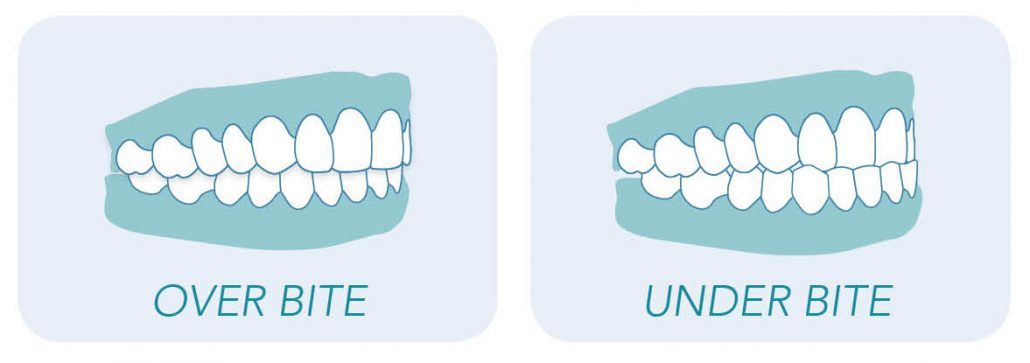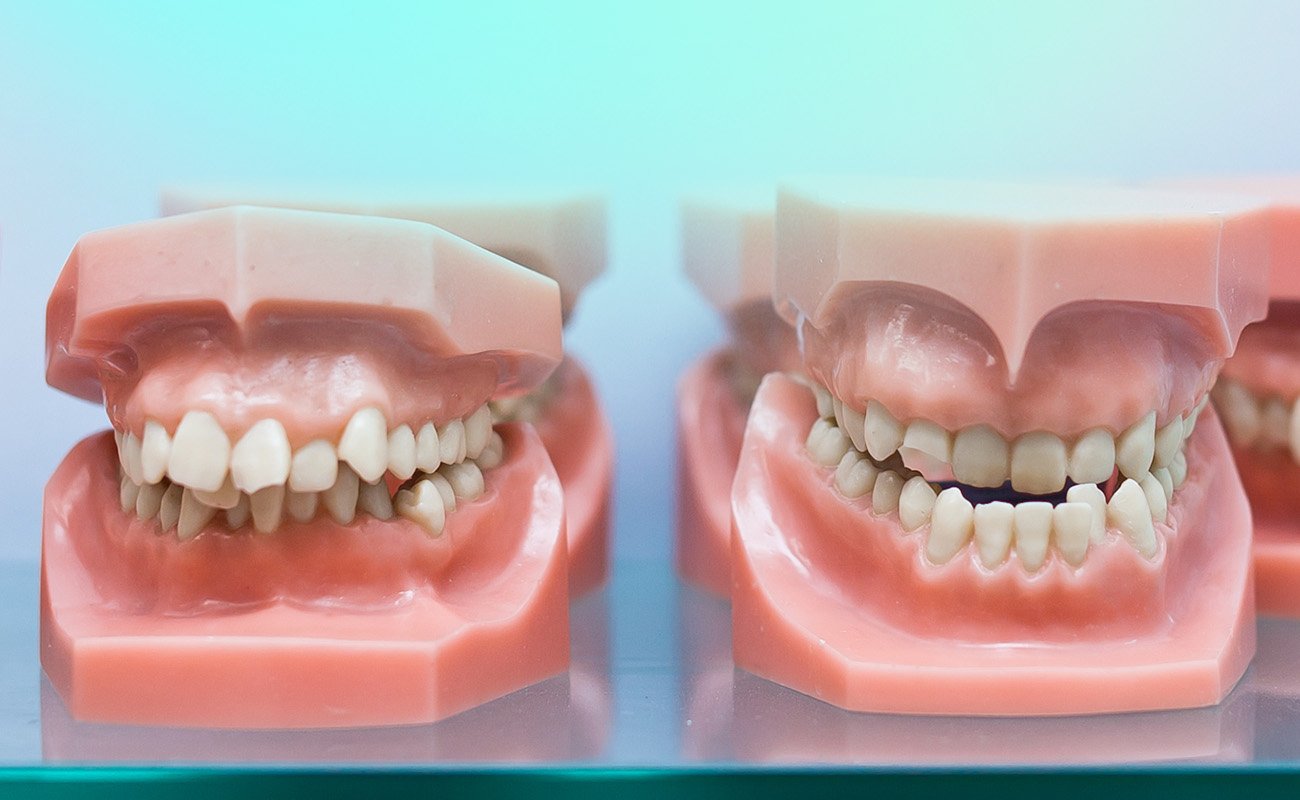Dental misalignments, often termed malocclusions, come in various forms and can lead to complications if not addressed. Among the most common types of malocclusions are overbites and underbites. These conditions relate to the alignment of the upper and lower front teeth, but they have specific characteristics, causes, and consequences. This article provides an in-depth look at overbites and underbites, exploring their differences, causes, potential effects, and available treatments.
Overbite
An overbite refers to how the upper and lower teeth fit together when the jaw is closed. Specifically, it means the upper front teeth substantially overlap the lower front teeth vertically. A normal overbite is around 2-4 millimeters of overlap, but in an excessive overbite, the upper front teeth excessively cover the lower front teeth. This misalignment is one of the most common bite problems.

Causes of Overbite
The causes of overbites can vary, but they usually involve a combination of genetic and environmental factors. Some common causes of overbite include:
- Genetics: A person’s jaw and teeth may naturally be prone to an overbite due to inherited traits.
- Thumb Sucking: Prolonged thumb sucking during early childhood can cause the development of an overbite, as this habit puts pressure on the front teeth and moves them forward.
- Tongue Thrusting: Children who thrust their tongue against their teeth while swallowing may also develop an overbite.
- Improperly Fitted Dental Restorations: Dental work, such as crowns and fillings, that are not properly fitted can lead to an overbite if they force the teeth into an incorrect position.
Consequences of Untreated Overbite
While overbites may seem like just a cosmetic issue, leaving them untreated can lead to serious oral health complications. Let’s explore some of the potential consequences that can arise if excessive overbites are not properly corrected with orthodontic intervention:
- TMJ Pain: An untreated overbite can lead to jaw pain or temporomandibular joint disorders (TMD), as the misaligned jaw forces the muscles and joints to work harder than normal.
- Difficulty Breathing: Some people with severe overbites may experience breathing challenges due to the altered shape of the nasal passages and airway obstruction.
- Increased Risk of Trauma to Front Teeth: The increased overlap between the upper and lower teeth might make them more susceptible to injury, such as chipping or cracks, during sports or accidents.
- Headaches: Misaligned bites may cause headaches due to muscle strain and tension associated with the improper jaw position.
- Uneven Wear of the Enamel: The uneven distribution of force while biting and chewing can lead to premature wear and tear of the tooth enamel, resulting in sensitivity and further dental issues.
- Speech Issues: An overbite may cause speech problems, making it difficult for individuals to pronounce certain sounds and words clearly.
- Difficulty Chewing and Biting: Misaligned teeth may make it challenging for individuals to properly chew and bite food, causing discomfort and affecting their overall digestion process.
- Increased Risk of Tooth Decay and Gum Disease: The improper positioning of teeth in an overbite may cause plaque buildup and make it harder to maintain proper oral hygiene, increasing the risk of tooth decay and gum disease.
- Aesthetic Issues: An untreated overbite might affect a person’s appearance, leading to self-consciousness and a lack of confidence in social situations.
- Sleep-Disordered Breathing: In severe cases, an overbite may be associated with sleep-disordered breathing, such as obstructive sleep apnea, due to the negative effect on the airway passage.
See also: Fixing Overjet Issues With Braces and Other Orthodontics
Worth Knowing
A study featured in the European Journal of Paediatric Dentistry finds that around the world, 56% of people experience malocclusion, with this condition affecting both genders equally.
Underbite
The reverse of an overbite is an underbite. An underbite is a type of malocclusion where the lower row of teeth sits in front of the upper row of teeth when the jaws are closed. This causes the lower teeth to protrude outward beyond the upper front teeth. An underbite results from jaw alignment issues rather than the teeth themselves being out of place. Orthodontic treatments like braces or surgery are often employed to correct underbites and improve both dental function and aesthetics.
Causes of Underbite
- Genetics: In many cases, an underbite is inherited, as genes determine a person’s jaw and tooth structure. If a family member has an underbite, the likelihood of developing one increases.
- Bad Habits: Certain habits, like thumb-sucking or mouth breathing, can affect a child’s facial development, leading to an underbite. It is crucial to address these habits early on to prevent long-term complications.
- Jaw Growth Discrepancy: Irregular growth patterns of the upper or lower jaw can lead to an underbite. An overdeveloped lower jaw or an underdeveloped upper jaw can result in the lower teeth protruding in front of the upper teeth.
Consequences of Untreated Underbite
Let’s look at some of the potential consequences that can develop if excessive underbites are not properly treated with orthodontics:
- TMJ Pain: An untreated underbite can contribute to temporomandibular joint (TMJ) pain. The misalignment of the jaw can put excessive stress on the joint, leading to discomfort and difficulty in jaw movement.
- Mouth Breathing: Patients with underbites may have difficulty closing their mouth comfortably, leading to mouth breathing. This can cause dry mouth and an increased risk of oral infections.
- Sleep Apnea and Snoring: The misalignment of the jaw, combined with mouth breathing, can contribute to sleep apnea and snoring. This can result in poor sleep quality and related health issues.
- Bruxism: Untreated underbites may increase the risk of bruxism, or teeth grinding. This can cause further damage to the teeth, increased pain, and discomfort.
- Increased Risk of Tooth Decay and Gum Disease: Underbites make it more difficult to clean the teeth properly, leading to an increased risk of tooth decay and gum disease.
- Aesthetic Issues: The appearance of an underbite can lead to self-consciousness and decreased self-esteem, due to the prominence of the lower jaw and teeth.
- Speech Issues: Misaligned teeth in underbites can affect speech patterns and cause difficulty pronouncing certain words or sounds.
- Chipping and Breaking of Teeth: The uneven distribution of pressure during biting and chewing can cause teeth to chip or break more easily in individuals with underbites.
- Pain in the Jaw when Eating: The uneven alignment of teeth can create discomfort and pain in the jaw when eating, making it difficult to chew and enjoy food.
- Increased Risk of Trauma to Lower Teeth: Protruding lower teeth are more susceptible to injury, as they are less protected by the upper teeth and jaw.
- Increased Risk of Headaches and Earaches: The tension and stress on the jaw caused by an untreated underbite can lead to headaches and earaches, further affecting the patient’s overall comfort and quality of life.
- Uneven Wear of the Enamel: The misalignment of teeth in an underbite can cause uneven wear on the enamel, leading to sensitivity and potential damage to the tooth structure.
See also: How to Fix Open Bite Naturally
Treatment
Now that we understand what overbites and underbites are and the issues they can cause, let’s explore the orthodontic treatments available to properly realign the bite.
Braces
Braces are a standard and effective treatment for both underbites and overbites. Metal or ceramic brackets are attached to the teeth and connected with wires or rubber bands, gradually moving the teeth into proper alignment over time. Treatment duration varies depending on the severity of the case but usually takes between one and two years.
Invisalign and Clear Aligners
Invisalign and other clear aligners offer a more discreet alternative to traditional braces for treating underbites and overbites. Custom-made plastic trays are designed to fit snugly and shift the teeth incrementally to the desired position. The trays are replaced every few weeks as the teeth move. Clear aligners are suitable for mild to moderate cases.
If you are looking for an affordable and efficient teeth straightening solution then invisible braces are a great choice. Here is a selection of companies to help you with your selection.

Byte
An affordable option with refundable impression kits, free HyperByte, and a Byte for Life guarantee.
Check out Byte Aligners
Candid
A hybrid of in-office and at-home treatment that provides 1-on-1 orthodontist support.
Check out Candid AlignersOrthognathic Surgery
For severe cases of underbite or overbite, orthognathic surgery may be recommended. The procedure involves correcting malocclusions by surgically repositioning the jawbone. This treatment is typically used in conjunction with braces or other orthodontic methods to ensure proper alignment and bite function. Recovery time varies depending on the complexity of the surgery and the individual patient, but it’s usually followed by a period of orthodontic treatment to fine-tune the results.
Underbite vs Overbite – Conclusion
Overbites and underbites are specific types of dental misalignments, each with their unique characteristics and causes. Leaving them untreated can lead to various complications, both cosmetic and health-related. Fortunately, advancements in orthodontic treatments offer effective solutions for both overbites and underbites, ensuring that individuals can achieve not only an improved appearance but also better oral health and overall well-being.
Frequently Asked Questions
What are the main differences between underbite and overbite?
An underbite is a dental condition where the lower teeth extend outward farther than the upper front teeth, causing the lower jaw to protrude. On the other hand, an overbite is when the upper front teeth extend forward, overlapping the lower teeth. The primary difference is the direction of misalignment: underbites have lower teeth projecting outward, while overbites have upper teeth overlapping lower teeth.
What causes an overbite or underbite?
Various factors can contribute to the development of underbites and overbites. Genetics plays a significant role, meaning you might inherit the condition from your parents. Additionally, childhood habits like thumb sucking, tongue thrusting, and mouth breathing can contribute to the development of an underbite or overbite.
How can you correct an underbite?
The treatment for an underbite typically depends on its severity. For mild cases, orthodontic treatment using braces or clear aligners can help correct the misalignment. In more severe cases, surgery might be required to shift the position of the jaw to achieve proper alignment.
How can you correct an overbite?
Similar to underbite treatment, overbite correction varies based on its severity. Mild to moderate overbite cases can be treated using orthodontic solutions such as braces, clear aligners, or retainers. Dental surgery may be necessary for more severe cases to realign the jaw or teeth.
Do overbites always require treatment?
Not all overbites require treatment, as some may be mild and not cause issues. However, significant overbites can lead to various problems, including difficulty speaking, chewing, or maintaining oral health. Treating the overbite is important in such situations to alleviate discomfort and prevent future complications.
Sources
Lombardo, G., Vena, F., Negri, P., Pagano, S., Barilotti, C., Paglia, L., Colombo, S., Orso, M., Cianetti, S., Worldwide prevalence of malocclusion in the different stages of dentition: A systematic review and meta-analysis. Eur J Paediatr Dent. 2020 Jun;21(2):115-122. DOI: 10.23804/ejpd.2020.21.02.05. Available online at: https://pubmed.ncbi.nlm.nih.gov/32567942/
Cenzato, N., Nobili, A., Maspero, C., Prevalence of Dental Malocclusions in Different Geographical Areas: Scoping Review. Dent J (Basel). 2021 Oct; 9(10): 117. DOI: 10.3390/dj9100117. Available online at: https://www.ncbi.nlm.nih.gov/pmc/articles/PMC8534899/
Jaber, S. T., Hajeer, M. Y., Sultan, K., Treatment Effectiveness of Clear Aligners in Correcting Complicated and Severe Malocclusion Cases Compared to Fixed Orthodontic Appliances: A Systematic Review, Cureus. 2023 Apr; 15(4): e38311. DOI: 10.7759/cureus.38311. Available online at: https://www.ncbi.nlm.nih.gov/pmc/articles/PMC10148732/
Zere, E., Chaudhari, P. K., Sharan, J., Dhingra, K., Tiwari, N., Developing Class III malocclusions: challenges and solutions. Clin Cosmet Investig Dent. 2018; 10: 99–116. DOI: 10.2147/CCIDE.S134303. Available online at: https://www.ncbi.nlm.nih.gov/pmc/articles/PMC6016584/
Hong Liu, Jian-Xue Li, Non-surgical treatment of an Angle Class III malocclusion in adults. Int J Clin Exp Med. 2013. Available online at: https://www.ncbi.nlm.nih.gov/pmc/articles/PMC3798208/
Khosravi R, et al. Management of overbite with the Invisalign appliance. Am J Orthod Dentofacial Orthop 2017;151:691e699.e2. Available online at: https://pubmed.ncbi.nlm.nih.gov/28364892/
Lombardo, G., Vena, F., Negri, P., Pagano, S., Barilotti, C., Paglia, L., Colombo, S., Orso, M., Cianetti, S., Worldwide prevalence of malocclusion in the different stages of dentition: A systematic review and meta-analysis. Eur J Paediatr Dent. 2020 Jun;21(2):115-122. DOI: 10.23804/ejpd.2020.21.02.05. Available online at: https://pubmed.ncbi.nlm.nih.gov/32567942/

